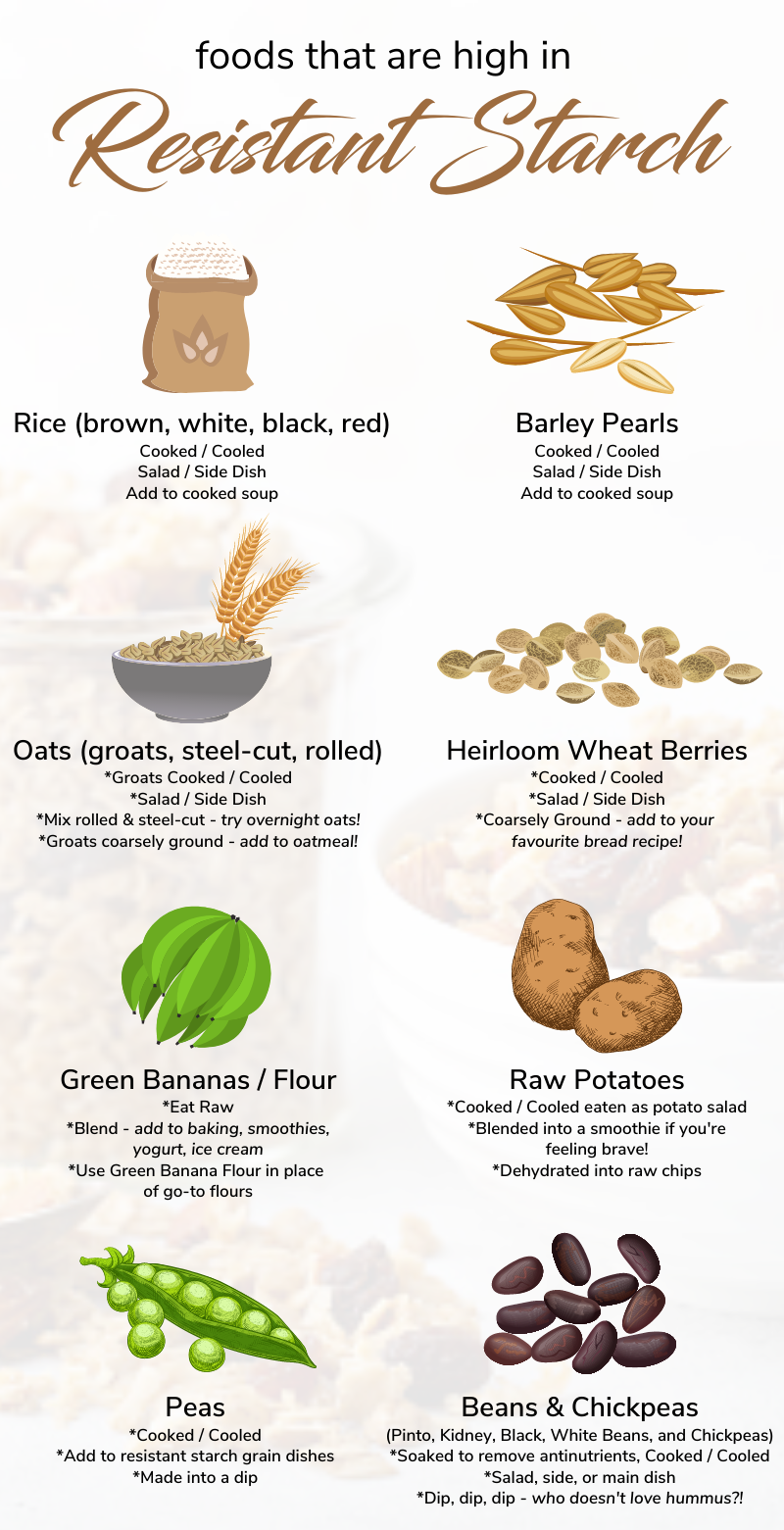We all know the importance of getting enough fiber into our diets, but doing so is easier said than done for many.
Firstly, fiber-rich foods just aren’t that fun! This might explain why so many choose to eat things that are chock full of flavour instead of a piece of celery.
Secondly, fiber-rich foods are mostly complex carbohydrates. Because they convert into glucose as a source of energy—they have a bad rap, so many people avoid them altogether.
Thirdly, there are many health-conscious folks out there who aim for a whole food diet, but struggle with fiber-rich foods due to underlying digestive issues.
However, fiber really is terrific—and way more than just “bulky roughage.” There are many kinds that do different things, but today we are going to focus on prebiotics in the context of digestion, and their critical role within the microbiome.
What are Prebiotics?
Prebiotics have a few definitions, but the latest is a selectively fermented ingredient that allows specific changes, both in composition and/or activity of the gastrointestinal microbiota.1 In short, they feed your probiotics and interestingly not all fibers can be classified as prebiotics; however, most prebiotics are dietary fibers.1
What is Resistant Starch?
Seeing as the world of fiber is vast, it’s no surprise that many prebiotic fibers exist. Further, research has confirmed that the most interesting and powerful prebiotic fibers are a class known as resistant starch. I know the word “starch’ is very scary for many people, but it’s important to bear in mind there are three kinds of starch—rapidly digestible, slowly digestible, and resistant; therefore, not all starch types are created equally and used by the body identically. Resistant starch types are literal gladiators with respect to their impact on satiety, digestion, blood sugar, the microbiome, and other chronic diseases. So let’s dig deeper into their unique properties.

Unlike their adulterated, rapidly digestible starch counterparts (refined white flour products/cereals full of refined sugar), resistant starch cannot be digested by amylases in the small intestine and passes to the colon to be fermented by microbiota.2 This fermentation results in the highly beneficial end products of acetate, propionate, and butyrate. These short-chain fatty acids (SCFA) all contribute to healthy intestinal tissue, immune function, glucose balance, fat metabolism, and appetite. They also help lower the pH of the gut and reduce levels of toxic ammonia in the gut and blood.3 Butyrate in particular packs a punch seeing it also modulates intestinal inflammation, has anti-tumor properties, helps the gut retain water, and heals damaged mucosa.
Conversely, rapidly digestible food starch is rapidly digested and absorbed as glucose, potentiating a hyperglycemic response and triggering insulin secretion and tissue-specific intracellular uptake of glucose that can then result in hypoglycemia. Repetition of this hyper-and hypoglycemic cycle appears to result in insulin resistance and type 2 diabetes.2
Types of Resistant Starch
There are a few classes of resistant starch, but today we are going to focus on Resistant Starch (RS) Types 1, 2, and 3.
- RS1 is defined as “physically inaccessible starch” and is made up of the whole kernel, or coarsely ground cereal grain, seeds, and legumes such as wheat berries, oats, barley, rice, peas and lentils.
- RS2 is defined as “granular or crystalline starch” and is made up of raw potato, green banana and high amylose corn.
- RS3 is defined “as retrograded, or reassociated starch” and is made up of RS1 and RS2 starches that have been cooked and cooled.
Now, you might be thinking, “Wow, I eat whole wheat bread, oatmeal and tacos every Tuesday, so I must be getting all the benefits of resistant starch, right?” Well, not exactly. Because the different types of resistant starch differ in their composition and structure, the effects of processing on each type of resistant starch need to be considered.2
RS1 grains/kernels have a rigid outer structure, so it’s much harder to digest them; therefore, their RS capacity remains intact. However, processing, refining and grinding break down this rigid structure and decreases the RS content. This explains why there is a fundamental difference between whole-grain kernels and processed white flour. They may come from the same source, but are not the same in the end results they produce. Interestingly, a very recent cohort study involving 21 countries confirmed that high consumption of refined grains was associated with an increased risk of death and cardiovascular disease. However, whole grain and white rice consumption were not associated with these outcomes, which further demonstrates that not all carbohydrates are created equally. Lastly, it appears that grains are less resistant to digestion as compared to their legume counterparts.
With RS2 the resistant starch is lost through cooking and ripening. This is notable because most people eat cooked potatoes and ripe bananas. Unfortunately, they lose their RS in these forms, yet they have some of the highest RS concentrations in their raw and unripe forms.
RS3 are interesting in that they are comprised of RS1 and RS2 and form when they are cooked and then cooled. Seeing RS are rich in amylose (a polysaccharide), they have interesting properties. When cooked in water, they absorb it and swell up; however, when they are cooled, they re-crystallize. Although less saturated, this “rearrangement” process literally restores the RS content that was lost from cooking! Pretty neat, right?
The research methods vary, but it appears that moisture and heat are required for this process to occur; thus, steaming, boiling, baking and roasting are the suggested cooking methods. For optimal cooling, it’s suggested refrigerating items for up to 24 hours. Although the RS content is higher when eating cool, or unheated RS3 foods, they can be gently reheated to temperatures up to 55℃/130℉.

This list is in no way complete based on the research; however, for the sake of simplicity, we’re going to stick to the basics. Further, corn—specifically high amylose is one of the highest RS foods and retains much of its content after cooking. Unfortunately, corn is one of the most controversial foods in the world, seeing it’s an allergen, high GMO and the raw material for high fructose corn syrup. That said, it’s not surprising many avoid it and why it has been left off the list. However, if you’re cool with corn, then make sure it’s organic, heirloom (blue, purple, red and black), or verified non-GMO and in its whole form.
Potatoes are similar in that they are one of the highest RS sources in their raw and starch forms, but lose their RS when cooked. Although cooking/cooling restores some of their RS content, the glycemic index (GI) of cooked potatoes is high which is a concern. Potatoes are also classified as a nightshade which is problematic for many and often avoided. However, if you’re okay with potatoes, get colourful and stick to the blue, red, and purple varieties and make sure to eat the skin because it’s full of vital nutrients. It’s best to eat cooked potatoes cold, seeing even gentle reheating will lower the RS and increase the GI. Lastly, it has been noted that many who are affected by nightshades can tolerate potato starch, but speak with your primary health provider before adding it to your diet.
Although this insight into the world of RS is truly amazing, it needs to be taken with a grain of salt. In no way will eating these foods—even in the proper way—solve every person’s digestive issues or underlying conditions. We are all genetically diverse, and certain lifestyle factors address why certain issues arise for some and not for others. With most digestive issues, many are so far gone that these healing foods actually worsen symptoms. There are a few reasons for this, but the main one is aggressive dysbiosis, which makes it difficult to digest RS because they are often higher FODMAP foods. It’s quite a scenario; thus, when it comes to dysbiosis it would be beneficial to work with our registered holistic nutritionist to incorporate these foods with a systematic approach. However, a good personal rule of thumb is to only eat what makes you feel good, limit portions where needed and start slow when adding in any new foods—especially RS.
Seeing diet alone can be a challenge when it comes to healing digestive issues for many, a well-researched/manufactured Natural Health Product (NHP) should be considered.
Solnul™ is a RS made from potato and no, it’s not the same as what is found in one’s pantry. Solnul™ has been extensively researched and its production is controlled to ensure purity which offers a standardized dose. Although these factors don’t seem like much at face value, they make a huge difference when one is trying to effectively manage symptoms and heal. It’s also a game-changer, seeing it was able to increase beneficial Bifidobacterium at very low doses while relieving symptoms of gas, loose stool and constipation. This is quite an achievement, seeing documented doses were at 30 g/d.
The study demonstrated that a 3.5 g dose for 4 weeks increased Bifidobacterium by 350% and a 7 g dose for 1 week increased Bifidobacterium by 450%. In short, Solnul™ was able to increase gut bacteria at 1/10 of the documented dose!
If potatoes are not an option for you, but corn is, it may be worth considering prebiotic XOS (xylooligosaccharide). It’s usually found in a chewable tablet form, is non-GMO and is one of the few NHPs that has been studied in pregnancy. It also increases Bifidobacterium and alleviates both loose stool and constipation. It’s usually well-tolerated, excellent for travel and easy to take because it tastes like candy.
Another excellent prebiotic is Sunfiber® (partially hydrolyzed guar gum). It’s a tasteless, colourless, odourless powder that can be taken in water or added to food. It’s also been demonstrated to effectively reduce gas, loose stool and constipation while increasing Bifidobacterium and Lactobacillus.
If after all of this, fiber still causes you havoc, then it might be wise to consider increasing your polyphenol, aka antioxidant intake. Believe it, or not, on top of everything they already do, many also have prebiotic activity!
Several phenolics (curcumin, quercetin, and EGCG) have demonstrated prebiotic effects, but suffer from poor bioavailability. However, the citrus bioflavonoids hesperidin and naringin are far more bioavailable; thus, more effective as prebiotics. Although found in varying concentrations throughout the skins of the citrus family, hesperidin is most concentrated in oranges and naringin in grapefruits. Both have also been studied in animals and humans and are fairly easy to incorporate into one’s diet. Both have demonstrated increases in Bifidobacterium, Lactobacillus and SCFA concentrations, thereby acting as fuel for enterocytes, improving barrier function and inhibiting inflammation.4 Unfortunately, many studies are based on citrus juice intake, which is problematic because of the extremely high glycemic index due to the lack of fiber content. Further, these little magic bullets are concentrated in the bitter skin of citrus, so your best bet is to eat them whole and try and eat as much of the bitter white skin as possible. Seeing proper juicing methods certainly have their place, stick to cold-pressed if possible, or use a blender and water to make a pulpy raw juice smoothie. More information on hesperidin and naringin can be found here.

Lastly, although diet and diligent self-care via NHPs is invaluable, there is a time and place for the expertise of a trained professional. Moreover, seeing there are four subclasses of gut bacteria that cannot be taken in supplement form, but grown in your gut through specific parameters, seeking out a Pro is the most logical step—especially if you suffer from disordered digestion. NutriChem’s team of experts offers microbiome mapping and personalized solutions that reflect your specific needs and unique diversity, so book an appointment today and get to the root of your issues!
If you are interested in delving deeper into the importance of a healthy microbiome, head over here to get your copy of Biology of the Brain, by Kent Macleod, R.Ph. B.Sc. Phm.
*This article is not intended to represent medical advice. Please contact a qualified health practitioner if you want to use any natural health products for specific health conditions.
References
Lockyer, S., and A. P. Nugent. “Health Effects of Resistant Starch.” Nutrition Bulletin 42.1 (2017): 10-41. Print.
Haub, Mark D., Kelcie L. Hubach, Enas K. Al-tamimi, Sammy Ornelas, and Paul A. Seib. “Different Types of Resistant Starch Elicit Different Glucose Responses in Humans.” Journal of Nutrition and Metabolism 2010 (2010): 1-4. Print.
Nakayoshi, Yuuki, Sumiko Nakamura, Yoji Kameo, Daisuke Shiiba, Yoshihisa Katsuragi, and Ken’ichi Ohtsubo. “Measurement of Resistant Starch Content in Cooked Rice and Analysis of Gelatinization and Retrogradation Characteristics.” Bioscience, Biotechnology, and Biochemistry 79.11 (2015): 1860-866. Print.
Chen, Liyong, Ruiping Liu, Chengyong Qin, Yan Meng, Jie Zhang, Yun Wang, and Guifa Xu. “Sources and Intake of Resistant Starch in the Chinese Diet.” Asia Pacific Journal of Clinical Nutrition. U.S. National Library of Medicine, 2010. Web. 18 Feb. 2021.
Fabbri, Adriana D.T., Raymond W. Schacht, and Guy A. Crosby. “Evaluation of Resistant Starch Content of Cooked Black Beans, Pinto Beans, and Chickpeas.” NFS Journal 3 (2016): 8-12. Print.
TATEYAMA, Ichiro, Koji HASHII, Ikuo JOHNO, Taeko IINO, Kouichi HIRAI, Yoshihide SUWA, and Yoshinobu KISO. “Effect of Xylooligosaccharide Intake on Severe Constipation in Pregnant Women.” Journal of Nutritional Science and Vitaminology 51.6 (2005): 445-48. Print.
Salvin, Joanne L., PhD, and Norman A. Greenberg, PhD. “Partially Hydrolyzed Guar Gum: Clinical Nutrition Uses.” Nutrition (Burbank, Los Angeles County, Calif.). U.S. National Library of Medicine, 2003. Web. 18 Feb. 2021. <https://pubmed.ncbi.nlm.nih.gov/12781858/>.
Shabbir, Umair, Momna Rubab, Eric Banan-Mwine Daliri, Ramachandran Chelliah, Ahsan Javed, and Deog-Hwan Oh. “Curcumin, Quercetin, Catechins and Metabolic Diseases: The Role of Gut Microbiota.” Nutrients 13.1 (2021): 206. Print.
Aschoff, Julian K., Sabrina Kaufmann, Onur Kalkan, Sybille Neidhart, Reinhold Carle, and Ralf M. Schweiggert. “Correction to In Vitro Bioaccessibility of Carotenoids, Flavonoids, and Vitamin C from Differently Processed Oranges and Orange Juices [Citrus Sinensis (L.) Osbeck].” Journal of Agricultural and Food Chemistry 63.9 (2015): 2582. Print.
“Exploring the Effects of RS2 on GI Health.” Solnul. 14 Nov. 2020. Web. 19 Feb. 2021.
Swaminathan, Sumathi, Mahshid Dehghan, John Michael Raj, Tinku Thomas, Sumathy Rangarajan, David Jenkins, Prem Mony, Viswanathan Mohan, Scott A. Lear, Alvaro Avezum, Patricio Lopez-Jaramillo, Annika Rosengren, Fernando Lanas, Khalid F. AlHabib, Antonio Dans, Mirac Vural Keskinler, Thandi Puoane, Biju Soman, Li Wei, Katarzyna Zatonska, Rafael Diaz, Noorhassim Ismail, Jephat Chifamba, Roya Kelishadi, Afzalhussein Yusufali, Rasha Khatib, Liu Xiaoyun, Hu Bo, Romaina Iqbal, Rita Yusuf, Karen Yeates, Koon Teo, and Salim Yusuf. “Associations of Cereal Grains Intake with Cardiovascular Disease and Mortality across 21 Countries in Prospective Urban and Rural Epidemiology Study: Prospective Cohort Study.” BMJ (2021): M4948. Print.



